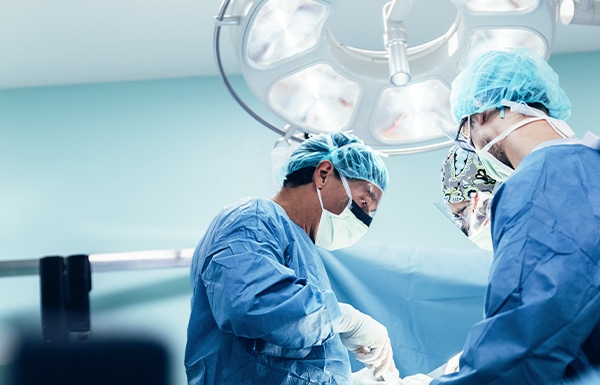Sentinel Lymph Node Biopsy by Dr Mark Gittos Plastic Surgeon NZ
Sentinel lymph node biopsy (SLNB) or Lumpectomy is a surgical procedure used to remove cancerous or other kinds of abnormal tissue from the breast or surrounds. During the procedure, Your Surgeon removes abnormal tissue along with the small amount of surrounding healthy tissue. It is also known as breast-conserving surgery because it involves the removal of the small part of the breast instead of the entire tissue as done in a mastectomy. SLNB is regarded as one of the best treatment options for early-stage breast cancer. In certain cases, it is also done to rule out a cancer diagnosis. The procedure is followed by radiation therapy which minimizes the chances of cancer recurring. Dr Mark Gittos is an Auckland plastic surgeon and a Breast Surgery expert – he performs Sentinel Node Biopsy in a number of hospitals in New Zealand.
Why is Lumpectomy Done?
The goal of the lumpectomy is to get rid of cancerous and abnormal tissues in the breast area. It is very effective for treating early-stage breast cancer, especially when followed by radiation therapy. In certain cases, surgeons do it to remove noncancerous/precancerous breast irregularities.
When is Lumpectomy Not a Good Option?
In certain cases, surgeons do not propose lumpectomy as a treatment option especially:
- When you have a history of scleroderma
- You struggle or have struggled with chronic inflammatory diseases such as systemic lupus erythematosus
- You have tumours in different quadrants of your breasts.
- When you have undergone radiation treatments in the past.
- If you have a very large tumour.
- If the can cancer has spread throughout your breasts.
- You have a large tumour and small breasts.
- You don’t have access to radiation therapy.
Download Dr Mark Gittos’ Guide to Cosmetic Breast Surgery

What to Expect with Sentinel Node Biopsy
Dr Gittos will begin the procedure by locating the area of the breast with abnormality. To do this, imaging tests are done. Typically, a mammogram or ultrasound is done to locate the tumour. Once, it is located, the surgeon will insert a thin wire, a radioactive seed or a needle. It might not be necessary if the lump can be easily located through the skin.
Your surgeon may suggest lymph node removal based on the results of the imaging tests. Typically, there are two kinds of lymph node removal procedures:
Sentinel Node Biopsy – During this procedure, the surgeon removes one or two cancer draining nodes which are sent for biopsy.
Axillary Lymph Node Dissection – A number of lymph nodes will be removed from the armpit area. This is usually done after a biopsy.
Does sentinel node mapping hurt?
- It is a minimally invasive procedure. During the mapping, you will feel a stinging sensation of the injection.
How to Prepare for a Lumpectomy
When you meet your surgeon, make sure to ask every question that is in your mind. Your surgeon will give you a handful of instructions to follow. Make sure you stick with them. Here is general guideline on how you can prepare for a lumpectomy:
- Avoid taking aspirin and other blood-thinning medications a few weeks prior to the lumpectomy.
- Check with your insurance company on whether they will cover the procedure or not.
- Avoid eating or drinking for at least 12 hours prior to the surgery.
- Arrange for someone to drive you home because it takes quite a while for anaesthesia to wear off.

The Sentinel Node Biopsy Surgery – Lumpectomy Procedure
The procedure is performed under general anesthesia. The good news is that you will be sleeping through the entire procedure and won’t feel a thing. Once the anesthesia is administered, the surgeon will create an incision in the skin which covers the tumour. Then the surgeon will remove the tumour and in certain cases, the surrounding tissue as well. Then, it will be sent for lab analysis. The same process will be done for sentinel lymph nodes if you require axillary lymph node dissection. After dissection, the surgeon will close the incision using sutures that will dissolve on their own. Afterwards, an adhesive strip and glue will be used on top of the suture to keep it closed.
How long does a sentinel node biopsy take?
- It typically takes 30 to 45 minutes for a surgeon to perform a sentinel node biopsy.
Is a lumpectomy major surgery?
- While lumpectomy is a very commonly performed surgery, it is major surgery with potential risks and complications.
How many lymph nodes are removed during a lumpectomy?
- During lumpectomy, the number of lymph nodes removed varies from 10 to 40. Usually, the number of nodes removed is less than 20.
How many nodes are removed in sentinel node biopsy?
- Firstly, it is important to understand that there are generally one to five sentinel nodes and all of them are removed during the surgery.
Are you put to sleep for a lymph node biopsy?
- Yes, you will be put to sleep for a lymph node biopsy as it is performed under general anaesthesia.
Does a lymph node needle biopsy hurt?
- No, it will not hurt because the biopsy is done under anaesthesia. Apart from the initial prick from the needle, you will not feel a thing.
Recovery after Sentinel Node Biopsy
Immediately after the surgery, you will be taken to the recovery room where your blood pressure, breathing and pulse will be monitored to ensure everything is fine. Usually, the patient is released as soon as the condition is stable. In case of axillary lymph node dissection, you will be required to stay in a hospital for at least a day.
After the surgery, you will have:
- A bandage over the surgical site.
- Have a bit of pain and numbness near the incision site.
- You will be asked to take pain medications and antibiotics.
- You will need to restrict the activity level.
- Need to come in for follow up appointments after 7 to 14 days.
How painful is a sentinel node biopsy?
- You will not feel a thing during the biopsy. After the biopsy, you will feel sore near your incision. You can take over the counter pain killers while your incision heals.
How long does swelling last after sentinel node biopsy?
- The swelling typically lasts a week after the sentinel node biopsy.
How long does a lymph node biopsy take to heal?
- It will take around 2 weeks for the incision to heal after a lymph node biopsy.
How long does it take to heal from a lumpectomy?
- Healing time varies from person to person. Most people are healed in about a week’s time after lumpectomy.
How should I sleep after a lumpectomy?
- Sleep on your back and keep a few pillows underneath your shoulders and head to keep them alleviated.
How common is lymphedema after sentinel node biopsy?
- The risk of getting lymphedema is very low after a sentinel node biopsy. Around 0 to 7 people out of every 100 people have a risk of developing lymphedema.
Understanding Results of Your Sentinel Node Biopsy – Lumpectomy
Most people are concerned about when the results will be available. They are typically available within a week’s time frame. Once the results are available, your surgeon will call you in for an appointment to explain the results. If you need further treatments, you can expect to have:
- A discussion on surgery if the margins around tumours aren’t free from cancer.
- A meeting with an oncologist to discuss alternative treatments such as chemo, hormone therapy or a combination of both.
- A discussion regarding radiation treatments if you are sensitive to other treatments.
- Meet a counsellor if you need support with breast cancer.
What happens after sentinel node biopsy?
- Once the sentinel node is biopsy is done, most people do not have any side effects. Some people do report minor pain and bruising at the incision site, combined with slight swelling. Some individuals also experience tiredness after the biopsy.
What percentage of enlarged lymph nodes are malignant?
- For people below the age of 40, there is a 0.4 per cent chance that enlarged lymph nodes are cancerous. For people above the age of 40, the chance of enlarged nodes becoming malignant becomes 4 per cent. In children, it is common to have swollen nodes and they are typically not related to cancer.
What happens if sentinel node biopsy is positive?
- The positive biopsy indicates that the cancer cells have been found in the sentinel nodes. In most cases, the surgeon will use the results to determine the stage of cancer and move towards the axillary lymph node dissection.
How accurate is sentinel node biopsy?
- The accuracy of sentinel node biopsy is about 96%.
Are most lymph node biopsies benign?
- About 45% of lymph node biopsies are benign. Lymph nodes might be swollen due to a variety of other reasons such as infections, autoimmune problems and other diseases.
What are the signs that you have a cancerous lymph node?
- Here are a few signs that might be pointing towards a cancerous lymph node:
- Lumps under the skin; typically found under the armpit area, in the neck, and in the groin area.
- Night sweats are literally drenching.
- Itchy skin
- Excessive weight loss
- Loss of appetite
- Cough, chest pain and difficulty in breathing
- Extreme fatigue all day long
Can a surgeon tell if the lymph node is cancerous?
- Yes, surgeons can tell whether a node is cancerous or not by running a number of imaging tests to detect enlarged nodes and then do a biopsy to confirm whether the lymph node is cancerous or not.
Is sentinel node biopsy necessary for DCIS?
- Breast cancer guideline recommends surgeons to do a sentinel node biopsy on DCIS patients. It is not a necessity but it is generally recommended.
Potential Risks Associated With Lumpectomy
Following are the possible risks associated with Lumpectomy:
- Discomfort and pain at the incision site
- Bleeding
- Risks of developing an infection
- Tenderness surrounding the incision
- Hard scar tissue formation
- Change in the shape and appearance of breasts
FAQs about Sentinel Lymph Node Biopsy
How is a sentinel lymph node biopsy done?
- The first part is to detect the sentinel lymph node. Once, is it detected, a small incision is made on the skin covering it. The incision is typically half an inch. Then a pathologist checks the sentinel node for the presence of cancerous cells. In some cases, the node is sent to the pathologist to examine later. Or the cells are removed during the surgery.
What is the difference between sentinel and axillary lymph nodes?
- The node or nodes which are closest to cancerous cells are called sentinel cells. Surgically removing those nodes is termed as axillary lymph node removal.
When is sentinel node biopsy done?
- Sentinel node biopsy is done in three main ways; sentinel nodes are sent to the pathologist for examination, the pathologist examines sentinel nodes at the time of the surgery. Sometimes the cells are removed during the surgery to get rid of cancer.
How many sentinel nodes are in the armpit?
- There are three levels of axillary lymph nodes in the armpit area. The actual number can vary from person to person. Typically, the number of nodes in the axillary area vary from five to thirty.
What distinguishes a sentinel node?
- The sentinel node or nodes are hypothetically the first nodes that drain cancer.
Are sentinel nodes axillary nodes?
- Yes, sentinel nodes are axillary nodes that are closest to breast cancer.
Do lymph nodes grow back after removal?
- No, lymph nodes do not grow back after removal.
What are the side effects of having lymph nodes removed?
- Following are some of the possible side effects of removing lymph nodes (please note that these side effects do not occur for every single individual):
- Infections
- Fluid build-up is known as seroma
- Poor healing of the wound
- Numbness and minor pain in the treatment site
- Blood clots
- Nerve injury
- Poor arm movement
When lymph nodes are removed from the armpit, are there any side effects?
- Some of the most common side effects are swelling, pain and numbness in the treated area.
Does having lymph nodes removed affect your immune system?
- Yes, getting your lymph nodes removed will distort your immune system. There is always a risk of infection associated after removal of lymph nodes.
Medical Resources & Further Reading for Sentinel Lymph Node Biopsy
About Dr Mark Gittos FRACS (Plast) – New Zealand Plastic Surgeon
Practice locations in Herne Bay Auckland, Northland and Bay of Plenty – Kerikeri, Whangarei, New Plymouth & Tauranga
Dr Mark Gittos is a leading Specialist Plastic Surgeon and operates a practice in Herne Bay, Auckland and in the UK. The practice focuses on both surgical and non-surgical procedures, each designed to help restore, improve or change a physical characteristic or problem. The first step in every case is to talk through your personal requirements and explore all the options, before deciding on the most effective solution.
Dr Mark Gittos offers high quality, natural-looking cosmetic surgery results and is highly experienced in Breast, Body and Face Surgery having performed over 4000 Surgeries in the last 26 years. With worldwide expertise Dr Gittos is an expert in breast, face and body surgery for men & women.
Naturally, before any treatment is begun, we will explain clearly the advantages and risk factors; so that you have the information you need to make an informed decision that is best for you. Visit the practice to find out more.

NEXT STEPS
Please NOTE: Dr Gittos only performs surgery on non-smoker patients with a BMI less than 30. To check your BMI please visit the NZ Heart Foundation website. For help giving up smoking before surgery visit the Smoke Free website
Do your Research
- Read the Website and Blogs relevant to your procedure
- Browse our Frequently Asked Questions including how to choose a Surgeon for your procedure
- Download and read the FREE Guides to Surgery
What to Bring to your Plastic Surgeon Consultation
- Bring a friend or relative to help discuss the information and your choices
- Take lots of notes and read the documents provided thoroughly
- Dress in simple clothes as you may need to undress for examination
- Bring your medical referral and any relevant medical documents or test results
Book your Initial Surgery Consultation
- A Referral from your GP or specialist is helpful but NOT essential – you can have a consultation without a GP Referral
- Email us or Call on 09 529 5352 to arrange your surgeon consultation appointment.
- Book a consultation with Dr Gittos by paying the Consultation Fee – $350 incl GST
Traveling for Surgery? – Consider post-surgery luxury recovery in a Hotel with LuxeCare
Please contact us to arrange to book a consultation with our Specialist Plastic Surgeon or to speak with our Patient Care Advisor.
Send an enquiry form today or phone 09 529 5352 during Clinic Hours
